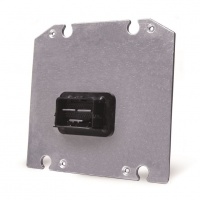SECM70
Contents
ECM-5634M-70
Hardware Features
- 70-Pin platform
- Microprocessor: ST SPC563M64, 80 MHz
- Memory: 1.5 M flash, 94 K RAM, 16 K serial EEPROM
- Operating Voltage: 8–32 Vdc, 36 V (jump start), 5.5 V (crank)
- Operating Temperature: –40 to +105 °C
Inputs
- VR or digital crank position sensor
- Digital cam position sensor
- Up to 14 ananlogs
- Up to 5 digital (4 switch, 1 speed)
- up to 2 switch-type oxygen sensors
- Optional wide-range oxygen sensor
- Up to 2 knock sensors
Outputs
- 6 high-impedance injector drivers (up to 4 low impedance injector drivers)
- Up to 8 electronic spark-triggers for smart injection coils
- 9 low-side drivers
- 3 lamp drivers
- 1 main power relay driver
- up to 2 H-bridge drivers
- Optional 3-phase brushless DC motor driver
- 1 sensor supply (5V)
Communications
- 2 CAN 2.0b channels
Product Summary
The SECM70 control platform fits a variety of applications, including gasoline and
natural gas engines for power generation, forklifts, lift trucks, and on-highway
vehicles. The SECM70 control is programmed to meet the specific needs of the
prime mover and its driven load.
At the heart of the SECM70 control is a powerful 32-bit ST SPC563M64
microprocessor that runs Woodward’s ControlCore operating system. Application
programming is accomplished via Woodward’s MotoHawk application software
tool. MotoHawk is a rapid controls system development tool that allows controls
engineers to quickly create controls software directly within Simulink diagrams,
which run on any MotoHawk-enabled electronic control modules. Application
developers work directly in the Simulink environment and with a one-step build
are able to go from an application model to a file that can be programmed directly
into Woodward production hardware. MotoHawk provides a high-level
programming environment for users who have control systems expertise but
don’t necessarily have specific embedded programming skills. Once the
application program has been generated and loaded into the SECM70 control via
the CAN port, the user can view variables and tune the control using an
appropriate service interface tool such as Woodward's Toolkit or MotoTune.
Connection to other devices, such as a diagnostic tool, is accomplished by
means of other CAN ports available on the control. The desired information flow
is programmed into the control via MotoTune or ToolKit.
The SECM70 control consists of a single rigid printed circuit board attached to an
aluminum housing using thermal adhesive, which is then closed and sealed with
an aluminum cover. Connections to the control are made via a single 70-pin
automotive-style sealed connector. The control can be mounted directly to the
engine or frame using vibration isolators which are available pre-installed on the
control or separately.
Datasheets
ECM-5634M-070 Family Engine Control Modules Product Manual (26776)
Part Numbers
| Part Num | Part w/ MTG HW |
HW Version | Features |
|---|---|---|---|
| 1751-6680 | 8923-2050 | 1452 (PROD) | Mobile Industrial |
| 1751-6649 | 8923-2051 | 1402 (DEV) | Mobile Industrial, on-the-fly calibratible |
| 1751-6681 | 8923-2052 | 1453 (PROD) | Power Generation |
| 1751-6650 | 8923-2053 | 1403 (DEV) | Power Generation, on-the-fly calibratible |
| 1751-6682 | 8923-2002 | 1459 (PROD) | Marine |
| 1751-6653 | 8923-1987 | 1409 (DEV) | Marine, on-the-fly calibratible |
| 1751-6683 | 1461 (PROD) | On-Highway (future release) | |
| 1751-6675 | 1411 (DEV) | On-Highway, on-the-fly calibratible (future release) |
Related Part Numbers
| Part Number | Description |
|---|---|
| 8923-1761 | Connector Kit |
| 8996-2162 8996-2163 8996-2164 |
Crimp Tools |
| 8996-2167 | Removal Tools |
| 5404-1141 | Pig Tail |
| 5404-1364 | Development Harness |
| 5404-1341 | Desktop Simulator Harness |
Compiler
Green Hills version 4.2.4
GCC for PowerPC EABI-SPE version 4.6.0
Frequently Asked Questions/Topics
Is the Marine variant suited for sensorless 3-phase brushless motor?
To introduce this answer, we review that it is possible to run a 3-phase brushless DC motor with and without position sensors. A position sensor can directly indicate the position of a motor shaft. Sensorless systems are advanced enough to determine the position of the shaft through back-EMF waveforms, although complexity will increase greatly under very small signal to noise ratios (when the motor is just starting and at very slow speeds.)
Woodward has design protected for sensorless 3-phase brushless DC motor operation in SECM70, but the Marine variant is not suited for this application.
The Marine variant SECM70 should always be designed to operate a 3-phase brushless motor with hall position sensors connected to module pins 56,57,58 for PhaseC, PhaseB, PhaseA, respectively. MotoHawk Input Capture blocks can then be used with the resources MotorPhaseVSense_A, MotorPhaseVSense_B, and MotorPhaseVSense_C. The Input Capture behavior allows the application to be notified of an input pin state change, which correlates to a sample every 60 degrees. The algorithm to calculate motor position and speed is outside the scope of what MotoHawk is providing in support of this module.
Can I diagnose PWM EST outputs?
Due to the nature of the hardware, EST diagnostics are only available when driven as a sequence and not as a PWM.
The ESTs have a caveat that certain groups must not turn off at the same time as there is shared diagnostic HW.
The groupings where you should avoid turning off at the same time are:
EST 1,2
EST 3,4
EST 5,6,7,8
